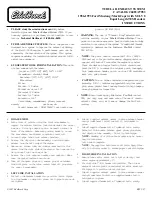
WWW.MANUALS.WS
WWW.MANUALS.WS
134
Do not connect it to or near any part that
moves when the engine is cranked.
When making the connections, to
avoid serious injury, do not lean
over the battery or accidentally let
the jumper cables or clamps touch
anything except the correct battery
terminals or the ground.
CAUTION
!
5. Start your engine in the normal way.
After starting, run it at about 2000 rpm
for several minutes with the accelera-
tor pedal lightly depressed.
6. Carefully disconnect the cables in the
exact reverse order: the negative
cable and then the positive cable.
7. Carefully dispose of the battery cover
cloths—they may now contain sulfuric
acid.
8. If removed, replace all the battery vent
plugs.
If the cause of your battery discharging is
not apparent (for example, lights left on),
you should have it checked.
If your engine stalls while driving
…
1. Reduce your speed gradually, keeping
a straight line. Move cautiously off the
road to a safe place.
2. Turn on your emergency flashers.
3. Try starting the engine again.
If the engine will not start, see “If your ve-
hicle will not start”.
If the engine is not running, the
power assist for the brakes and
steering will not work so steering
and braking will be much harder
than usual.
CAUTION
!
If your engine stalls while
driving
















































